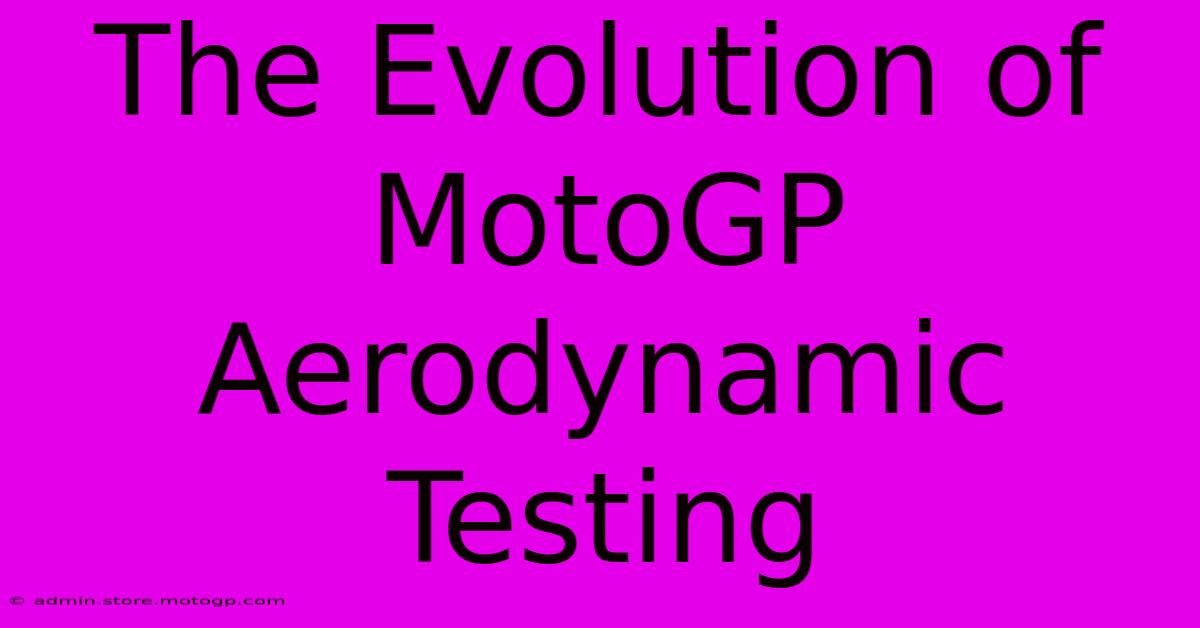The Evolution Of MotoGP Aerodynamic Testing

Table of Contents
The Evolution of MotoGP Aerodynamic Testing: From Intuition to Sophisticated Simulation
MotoGP, the pinnacle of motorcycle road racing, is a relentless pursuit of speed and performance. A crucial element in this quest is aerodynamics, and its evolution from rudimentary understanding to sophisticated scientific analysis is a fascinating story. This article delves into the history of aerodynamic testing in MotoGP, showcasing the technological advancements that have shaped the sport.
The Early Days: Intuition and Trackside Observation
In the early days of MotoGP (and its predecessor, the 500cc Grand Prix), aerodynamic testing was largely intuitive. Teams relied heavily on trackside observations, rider feedback, and basic wind tunnel testing, often employing scaled models or even full-sized motorcycles. Data acquisition was limited, and understanding the complex interplay of forces was less precise. Design changes were frequently driven by experimentation rather than detailed analysis. The focus was primarily on reducing drag, with less emphasis on downforce generation.
The Rise of Wind Tunnels: A Paradigm Shift
The introduction of sophisticated wind tunnels marked a turning point. These facilities allowed teams to accurately measure aerodynamic forces, airflow patterns, and pressure distributions across the motorcycle. This ability to quantify aerodynamic performance led to more data-driven design decisions. Initially, teams utilized relatively basic wind tunnels. However, the need for more precise data spurred the development of specialized facilities capable of simulating the extreme speeds and complex airflow dynamics of MotoGP bikes.
The Modern Era: Computational Fluid Dynamics (CFD) and Advanced Simulation
The advent of Computational Fluid Dynamics (CFD) revolutionized aerodynamic testing. CFD uses powerful computers to simulate airflow around the motorcycle, providing detailed insights into aerodynamic performance without the need for extensive physical testing. This allows engineers to rapidly explore numerous design variations, optimizing shapes and components for maximum efficiency. The combination of CFD and wind tunnel testing creates a powerful synergy, allowing for virtual prototyping and validation of CFD predictions.
Data Acquisition and Telemetry: Real-World Validation
Simultaneously, advancements in data acquisition and telemetry provided unprecedented levels of real-world data. Sensors on the motorcycles collect extensive information during track sessions, providing valuable feedback to validate CFD simulations and wind tunnel results. This closed-loop process enables engineers to constantly refine designs based on real-world performance.
Aerodynamic Innovations: From Wings to Winglets and Beyond
The evolution of aerodynamic testing has driven numerous innovations in MotoGP motorcycle design. The introduction of wings and winglets exemplifies this. Initially met with skepticism, these aerodynamic devices proved highly effective in generating downforce, improving stability at high speeds, and enhancing cornering performance. The design and placement of these components are now rigorously optimized using advanced testing methods.
The Future of Aerodynamic Testing: AI and Machine Learning
The future of MotoGP aerodynamic testing is likely to be shaped by artificial intelligence (AI) and machine learning (ML). These technologies offer the potential to automate the design process, analyze vast amounts of data, and identify optimal aerodynamic configurations with unprecedented speed and accuracy. The integration of AI and ML into the design and testing workflow will undoubtedly lead to even greater advancements in aerodynamic performance.
Conclusion: A Continuous Pursuit of Excellence
The evolution of aerodynamic testing in MotoGP reflects the relentless pursuit of performance excellence. From intuitive beginnings, the field has transformed into a sophisticated scientific discipline, leveraging advanced technology and data analysis to continually push the boundaries of motorcycle performance. The future promises even greater advancements, driven by the innovative spirit and technological prowess of the teams competing in this captivating sport.

Thank you for visiting our website wich cover about The Evolution Of MotoGP Aerodynamic Testing. We hope the information provided has been useful to you. Feel free to contact us if you have any questions or need further assistance. See you next time and dont miss to bookmark.
Featured Posts
-
Cota Austin Schedule Inside Scoop And Expert Tips
Feb 18, 2025
-
Moto Gp Helmet Technology What You Need To Know
Feb 18, 2025
-
Arrive Relaxed Race Ready F1 Shuttle
Feb 18, 2025
-
Unforgettable Thrills Cota Circuit Days
Feb 18, 2025
-
Understanding Moto Gp Sprint Races A Fans Guide
Feb 18, 2025
